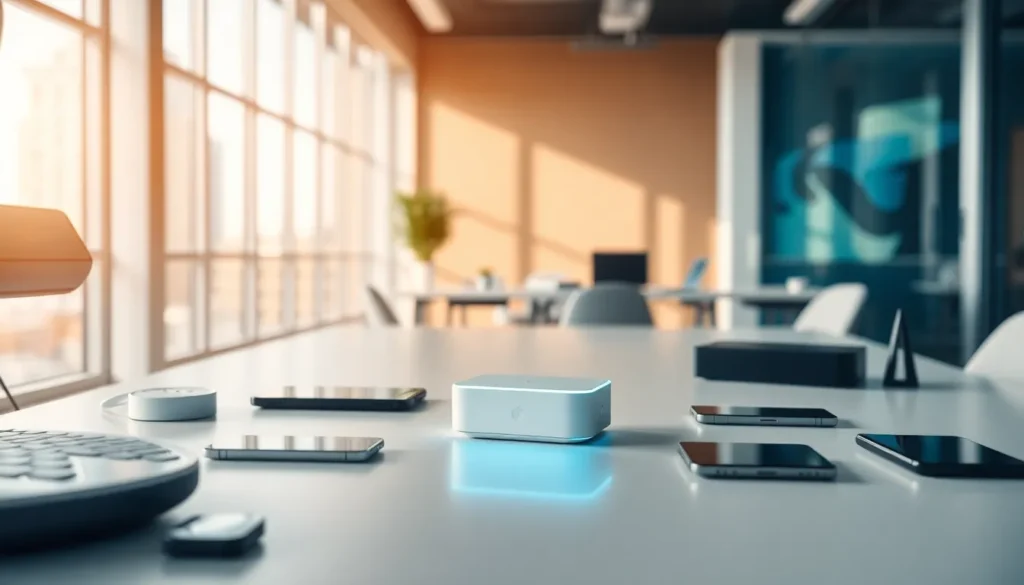Table of Contents
ToggleIn a world where even your fridge can text you, it’s no surprise that locks have gone smart too. But before diving headfirst into the future of home security, it’s crucial to ensure those digital door guardians can actually keep the bad guys out. Smart lock testing isn’t just a techie pastime; it’s a necessary step to guarantee peace of mind. After all, who wants to be the proud owner of a lock that’s more of a suggestion than a security measure?
Picture this: you’re heading home after a long day, your arms full of groceries, and you confidently tap your phone to unlock the door. But wait! Did you test that smart lock? If it fails, you might find yourself doing the grocery tango outside your own home. Join the ranks of savvy homeowners who prioritize smart lock testing and ensure their high-tech investments are worth every penny.
Overview of Smart Lock Testing
Testing smart locks ensures effective security for homes and enhances the reliability of modern technology. The rise of smart home innovation brings diverse features, including remote access, alerts, and integration with other smart devices. Testing processes must cover functionality, durability, and security measures.
Functionality testing examines how well the lock engages with smartphones or smart home systems. This includes checking the reliability of Bluetooth or Wi-Fi connections. Durability assessments determine how the lock performs under various environmental conditions. Components must withstand wear and tear while maintaining consistent functionality.
Security evaluations focus on identifying vulnerabilities that could be exploited. Experts conduct penetration testing to assess how the locks withstand cyber threats. Additionally, encryption methods used in smart locks require thorough examination to ensure data protection.
Compatibility with different operating systems is essential for a seamless user experience. The lock must integrate smoothly with iOS and Android devices. Quality assurance checks ensure that updates do not disrupt lock performance.
Regular testing can reveal potential concerns before they escalate. Actively monitoring performance helps prevent malfunctions that could compromise safety. Homeowners should engage in routine checks to verify smart lock functionality and security status.
Smart lock testing plays a crucial role in ensuring safety and reliability. Prioritizing thorough testing can provide peace of mind, knowing that security features function correctly. Emphasizing ongoing evaluations aids in maintaining the integrity of smart locks throughout their lifecycle.
Types of Smart Locks
Smart locks come in various types, each designed to meet specific user needs. Understanding these types helps homeowners select the most suitable option for their security requirements.
Keypad Smart Locks
Keypad smart locks utilize a numeric code for entry. Users input codes directly onto the lock’s keypad. This method offers convenience, as it eliminates the need for physical keys. Many keypad locks also feature temporary codes for guests, enhancing accessibility. Their battery life typically lasts several months, depending on usage frequency. Overall, these locks provide an effective blend of security and ease of access.
Bluetooth Smart Locks
Bluetooth smart locks connect directly to smartphones through Bluetooth technology. Users unlock their doors via dedicated apps on their devices. This option allows for remote locking and unlocking, enhancing home security while providing flexibility. Many models support multiple users, making it easy for family and visitors to access the home. Some Bluetooth locks even offer auto-unlock features that activate as users approach. These capabilities contribute to a seamless and efficient user experience.
Wi-Fi Smart Locks
Wi-Fi smart locks connect to a home’s Wi-Fi network for remote access via the internet. Owners can control their locks from anywhere using smartphone apps. The ability to receive real-time alerts further enhances security by notifying users of unauthorized entry attempts. Many Wi-Fi models integrate with smart home systems, allowing for automation and voice control. Updates to firmware often improve functionality and security protocols as well. Adopting a Wi-Fi smart lock ensures enhanced control and monitoring for homeowners.
Testing Methodologies
Testing methodologies for smart locks focus on ensuring a seamless and secure user experience. These tests evaluate functionality and security, which are critical for effective lock performance.
Functional Testing
Functional testing assesses how well a smart lock operates within various scenarios. Testers examine smartphone connectivity, verifying that locks respond promptly to commands. Interactions with smart home systems also undergo scrutiny, ensuring compatibility across all platforms. Different user cases simulate daily usage, including remote locking while users are away. Battery life tests evaluate performance under consistent use, confirming that locks maintain functionality for an extended period. Each test includes monitoring responsiveness to both app commands and physical key access, reinforcing the importance of reliable operation.
Security Testing
Security testing identifies vulnerabilities that could compromise the integrity of smart locks. Penetration testing simulates attacks, revealing weaknesses in encryption and data protection. Authentication methods, including biometric and password protocols, undergo evaluations to ensure robustness. Testers also analyze firmware for potential exploits that hackers might leverage for unauthorized access. Regular assessments of communication protocols maintain data integrity during interactions between the lock and user devices. Comprehensive security tests support homeowners’ peace of mind by confirming that smart locks provide reliable protection against unauthorized entry.
Tools and Equipment Used in Smart Lock Testing
Testing smart locks requires specific tools and equipment to assess performance and security effectively. Different testing environments dictate the necessary gear.
- Smartphone Devices
Smartphones play a vital role in testing Bluetooth and Wi-Fi smart locks. Testers use multiple smartphone models to ensure compatibility across various operating systems.
- Dedicated Testing Software
Specialized software simulates user interactions with smart locks. This software facilitates the examination of lock features, including remote access and notifications.
- Battery Testers
Battery life impacts functionality. Testers utilize battery testers to evaluate power consumption and performance under regular usage conditions.
- Environmental Chambers
Environmental chambers simulate extreme conditions like high humidity, temperature fluctuations, and dust. These chambers help assess the durability of smart locks in diverse environments.
- Network Analyzers
Network analyzers evaluate Wi-Fi signal strength and connectivity. Reliable connections are crucial for the smooth operation of internet-based smart locks.
- Security Testing Tools
Tools for penetration testing expose vulnerabilities. Security experts employ these tools to analyze encryption methods and authentication processes.
- Mechanical Tools
For traditional smart locks, mechanical tools assess physical durability. Testers evaluate the resistance against forced entry and wear over time.
- Automated Testing Systems
Automated systems streamline repetitive testing processes. They allow for continuous monitoring, improving efficiency in identifying potential issues.
Using these tools ensures comprehensive assessments of smart locks, addressing functionality, durability, and security effectively. Regularly updating testing methods alongside advancements in smart lock technology proves critical for maintaining user trust and safety.
Common Issues and Challenges
Testing smart locks presents several common issues and challenges. Connectivity problems often arise due to interference from multiple devices or weak Wi-Fi signals. Users may experience difficulty when the lock struggles to communicate with smartphones or smart home systems.
Battery performance also poses a challenge. Over time, battery life can decline, affecting functionality. Users might find themselves unable to unlock their doors when batteries run low, highlighting the need for regular battery checks and replacements.
Compatibility issues occur when locks fail to integrate smoothly with various operating systems. Discrepancies between different devices can hinder user experience, resulting in frustration. It remains crucial to check compatibility before installation.
Security vulnerabilities demand attention during testing. Penetration tests may reveal weaknesses that could expose homes to unauthorized access. Identifying these vulnerabilities early can prevent potential breaches, ensuring the safety of users’ properties.
Environmental durability is another concern. Smart locks must withstand various weather conditions and physical impacts. Failing to address these aspects may lead to malfunctions, diminishing overall reliability.
Firmware and update complications can disrupt lock performance. Software updates sometimes introduce bugs or inconsistencies that affect user experience. Routine quality assurance checks play an essential role in identifying and mitigating these issues.
User error also influences smart lock functionality. Misconfigured settings or incorrect usage can lead to lockouts or unexpected behavior. Providing clear instructions contributes to better user experiences.
Addressing these common challenges is vital in the smart lock testing process. Consistent testing and monitoring of these areas ensure improved reliability and user satisfaction.
Smart lock testing is crucial for ensuring security and functionality in modern homes. By prioritizing thorough assessments homeowners can mitigate risks associated with malfunctions and vulnerabilities. Regular testing not only enhances the reliability of these devices but also provides peace of mind.
Understanding the various types of smart locks available allows homeowners to choose the best options for their needs. With the right tools and methodologies in place testing can effectively address common challenges, ensuring that smart locks perform optimally in diverse conditions.
Investing time in smart lock testing ultimately safeguards homes and enhances the user experience, making it an essential practice in the age of smart technology.




